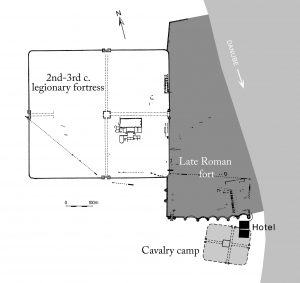The first cavalry fort of Óbuda
In Óbuda we can come across Roman remains or modern structures hiding them if we take a quick look every now and again to the right or the left. Last time, we explored the southern wall of the massive Late Roman fortress built in the 330s. To get to the Aquincum traffic jam blog’s next stop we need to go back nearly 300 years in time. Luckily, we only need to walk about 70 metres. Our destination is none other than the first known castellum alae of Óbuda.
So where are we now?
We’re heading south on Árpád Fejedelem Road, passing Serfőző Street. By the entrance of the Aquincum Hotel Budapest a stone inscription (more on this a little later), and a thick black line in the pavement of the hotel car park’s pavement indicate where the cavalry fort once stood.
But first the history!
The first known Roman army base in Óbuda was constructed under the Emperor Vespasian in 73 at a strategically important location. The fort, after all, stood on the bank of the Danube, roughly opposite the northern tip of Margit Island and at the end of the northwest-southeast road connecting the Danube and the Pilisvörösvár valley. Here the soldiers could keep control of both the road and the river crossing. (It’s important to note, however, that this was not the first Roman military base in Budapest; we know of a fort that already stood in modern-day Víziváros in AD 49.)
The Óbuda fort was built by the cavalry unit ala I Tungrorum Frontoniana. An ala in the Roman imperial army referred to an auxiliary cavalry unit that fought alongside the legions. Contrary to the legionaries, auxiliary troops were not Roman citizens. They gained this status at the end of their service.
The 500-strong cavalry unit stayed in the Óbuda fort until the end of the 1st century, when the ala was transferred to Campona, in modern-day Nagytétény. The fort, on the other hand, remained. While initially the base was a so-called earth-and-timber fort, it was rebuilt in stone later on and continued to be in use long after the construction of the legionary fortress nearby.

What can we see today?
While we can’t see the fort itself, we can easily spot its traces. Using different-colour stones, the pavement of the hotel car park indicates the path of the castellum’s 1.1-metre-thick eastern and northern walls, and the site of the porta praetoria’s (the fort’s main gate facing the Danube) northern tower. Next to the hotel’s entrance we can read the castellum’s reconstructed building inscription. Although only a few fragments of the stone tablet have surfaced, these allowed researchers to ascertain the fort’s precise date of construction and the identity of the ala that built it.
Soon we’ll continue our search for Roman remains as there are still plenty of other hidden and conspicuous monuments to discover in Óbuda; but more on those later.
All in all, I encourage everyone to have a look at the site of Óbuda’s earliest Roman military base on foot, or from the warmth of your car on a sunny spring morning – but only when the traffic isn’t moving!
Zoltán Quittner
Click here to read the previous entries of the Aquincum traffic jam blog!


